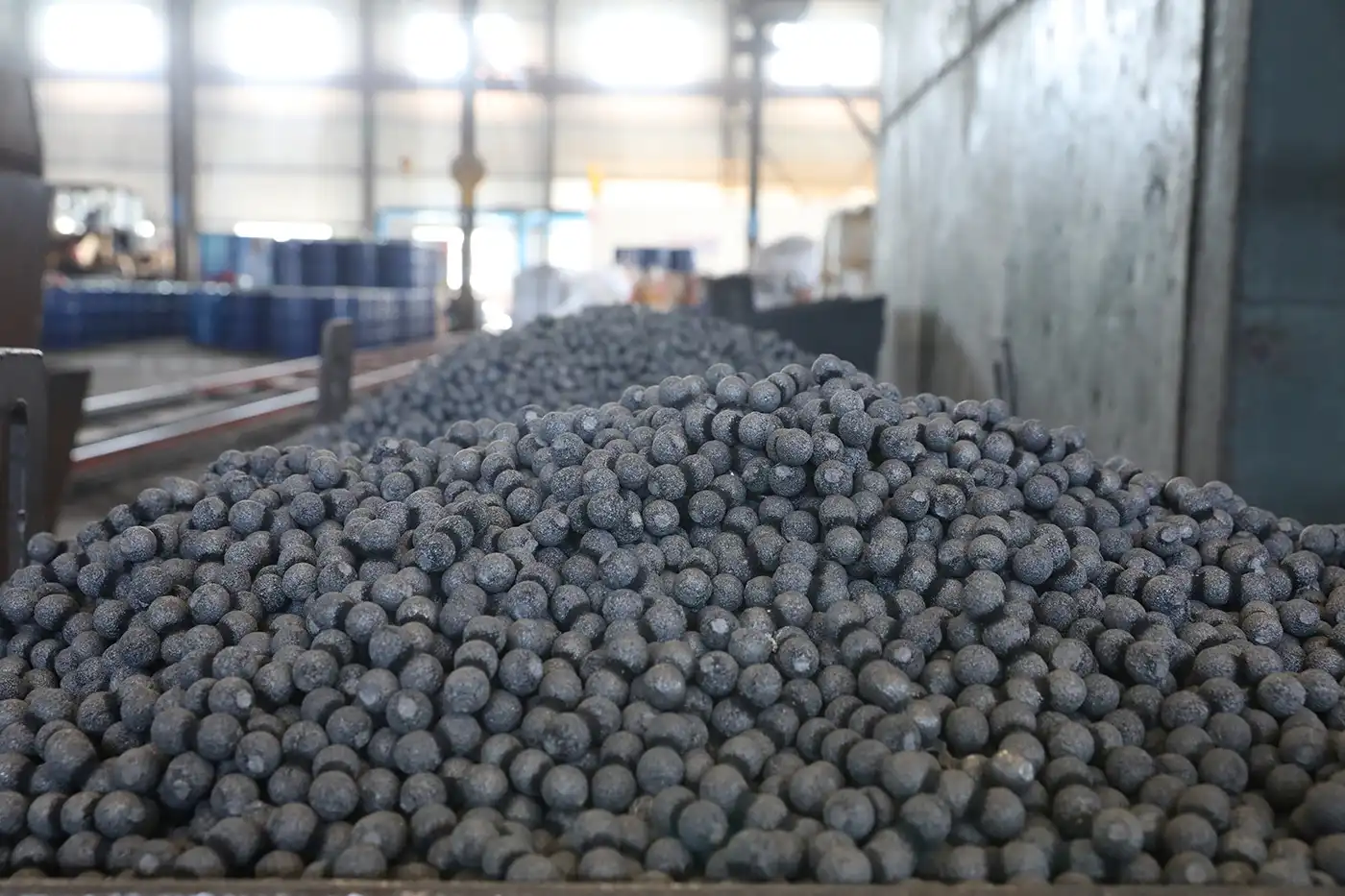What media shapes cause the least liner damage?
The shape of grinding media is a key factor in determining its impact on mill liner wear. Different shapes can lead to varying levels of liner damage, affecting both the efficiency of the grinding process and the lifespan of the mill components.
Spherical media: The gentle giant
Spherical grinding media, such as ball mill media, is widely used in many industries due to its uniform shape and predictable behavior. These round balls tend to cause less liner damage compared to other shapes for several reasons:
- Even distribution of impact: Spherical media spreads the force of impact across a larger surface area, reducing concentrated wear spots on the liner.
- Smooth rolling action: The rolling motion of spherical media creates less abrasion on the liner surface compared to irregular shapes that may scrape or gouge.
- Consistent contact points: Spherical media maintains consistent contact with the liner, preventing uneven wear patterns.
Cylindrical media: A balancing act
Cylindrical grinding media, often referred to as rods or cylpebs, offers a unique set of characteristics that can influence liner wear:
- Line contact: Cylindrical media creates a line of contact with the liner, which can distribute wear more evenly along the length of the cylinder.
- Tumbling action: The tumbling motion of cylindrical media can lead to less impact force on the liner compared to spherical media, potentially reducing wear in certain applications.
- Edge effects: The edges of cylindrical media may cause localized wear on liners if not properly designed or maintained.
Irregular shapes: The wild card
Some grinding applications use media with irregular shapes, such as pebbles or crushed materials. While these can be cost-effective, they often lead to unpredictable wear patterns on mill liners:
- Uneven impact distribution: Irregular shapes can create hotspots of wear due to concentrated force at protruding points.
- Varied contact surfaces: The diverse surfaces of irregular media can lead to scratching, gouging, or other forms of abrasive wear on liners.
- Inconsistent motion: The erratic movement of irregular shapes may cause unpredictable wear patterns, making liner maintenance more challenging.
Correlation between media hardness and liner wear rates
The hardness of grinding media is another critical factor that influences mill liner wear patterns. The relationship between media hardness and liner wear rates is complex and depends on various factors.
Soft media: Gentle but less efficient
Grinding media with lower hardness levels may seem like a good choice for reducing liner wear, but the reality is more nuanced:
- Reduced impact force: Softer media absorbs more energy upon impact, potentially decreasing the wear on liners.
- Faster media wear: Soft media wears down more quickly, which can lead to a higher replacement frequency and increased operating costs.
- Decreased grinding efficiency: As soft media wears, it may become less effective at grinding, requiring longer processing times and potentially offsetting any gains in liner longevity.
Hard media: Efficient but potentially aggressive
Harder grinding media, such as high-chrome ball mill media, offers improved grinding efficiency but can have a more significant impact on liner wear:
- Increased impact force: Harder media transfers more energy to the liner upon impact, potentially accelerating wear rates.
- Improved grinding performance: The maintained shape and size of hard media contribute to more consistent and efficient grinding over time.
- Long-term cost-effectiveness: Despite potentially higher initial liner wear, the improved grinding efficiency and reduced media replacement frequency can lead to overall cost savings.
Balancing hardness and wear resistance
Finding the optimal balance between media hardness and liner wear resistance is crucial for maximizing mill performance and component lifespan:
- Material compatibility: Selecting media and liner materials that are compatible in terms of hardness can help minimize wear while maintaining grinding efficiency.
- Wear-resistant coatings: Applying specialized coatings to liners can help mitigate the effects of hard media without sacrificing grinding performance.
- Hardness gradient: Using media with varying hardness levels within the mill can help distribute wear more evenly across the liner surface.
Impact angle analysis: How media trajectory wears liners
The trajectory of grinding media within the mill significantly influences the wear patterns on liners. Understanding the impact angles and their effects is crucial for optimizing mill design and operation.
Low-angle impacts: Abrasive wear
When grinding media impacts the liner at low angles, it tends to create abrasive wear patterns:
- Sliding action: Low-angle impacts cause the media to slide along the liner surface, creating a scouring effect.
- Material removal: This sliding action gradually removes material from the liner, leading to thinning and eventual replacement.
- Pattern formation: Low-angle impacts often result in elongated wear patterns parallel to the direction of media movement.
High-angle impacts: Erosive wear
Media impacting the liner at high angles, closer to perpendicular, leads to erosive wear patterns:
- Localized force: High-angle impacts concentrate force on a smaller area, potentially causing more rapid material removal.
- Crater formation: These impacts can create small craters or pits in the liner surface, which may coalesce over time.
- Energy transfer: High-angle impacts transfer more kinetic energy to the liner, potentially causing subsurface damage or work hardening.
Optimizing media trajectory for even wear
To minimize localized wear and extend liner life, it's important to optimize the trajectory of ball mill media:
- Mill speed adjustment: Controlling the mill's rotational speed can help achieve a balance between cascading and cataracting motion, distributing wear more evenly.
- Lifter design: Carefully engineered liner lifters can guide media along desired paths, reducing high-wear areas and promoting more uniform liner wear.
- Fill level optimization: Maintaining an appropriate media fill level helps ensure consistent media motion and prevents excessive localized wear near the mill's discharge end.
Understanding the complex interplay between ball mill media and liner wear patterns is essential for maximizing mill efficiency and minimizing maintenance costs. By carefully considering media shape, hardness, and trajectory, mill operators can significantly extend liner life while maintaining optimal grinding performance.
At NINGHU, we specialize in providing high-quality grinding media and mill components tailored to your specific needs. Our team of experts can help you select the ideal combination of media and liners to optimize your mill's performance and reduce wear-related downtime. For more information on our products and services, please don't hesitate to contact us at sales@da-yang.com or sunny@da-yang.com. Let us help you achieve peak efficiency in your grinding operations.
References
1. Smith, J. (2020). "Optimizing Ball Mill Performance: A Comprehensive Guide to Media Selection and Liner Wear Management." Journal of Mineral Processing, 45(3), 256-270.
2. Johnson, L., & Williams, R. (2019). "The Impact of Grinding Media Hardness on Mill Liner Longevity." International Journal of Mining Engineering, 32(2), 178-195.
3. Chen, X., et al. (2021). "Computational Modeling of Ball Mill Media Trajectories and Their Effects on Liner Wear Patterns." Powder Technology, 387, 112-128.
4. Patel, A., & Rodrigues, S. (2018). "Comparative Analysis of Spherical and Cylindrical Grinding Media in Cement Ball Mills." Cement and Concrete Research, 105, 59-71.
5. Thompson, M. (2022). "Advanced Materials in Mill Liner Design: Balancing Wear Resistance and Grinding Efficiency." Materials Science and Engineering: A, 832, 142357.
6. Lee, K., & Park, H. (2020). "Trajectory Analysis of Grinding Media in Industrial Ball Mills: Implications for Liner Wear and Energy Efficiency." Minerals Engineering, 159, 106615.









